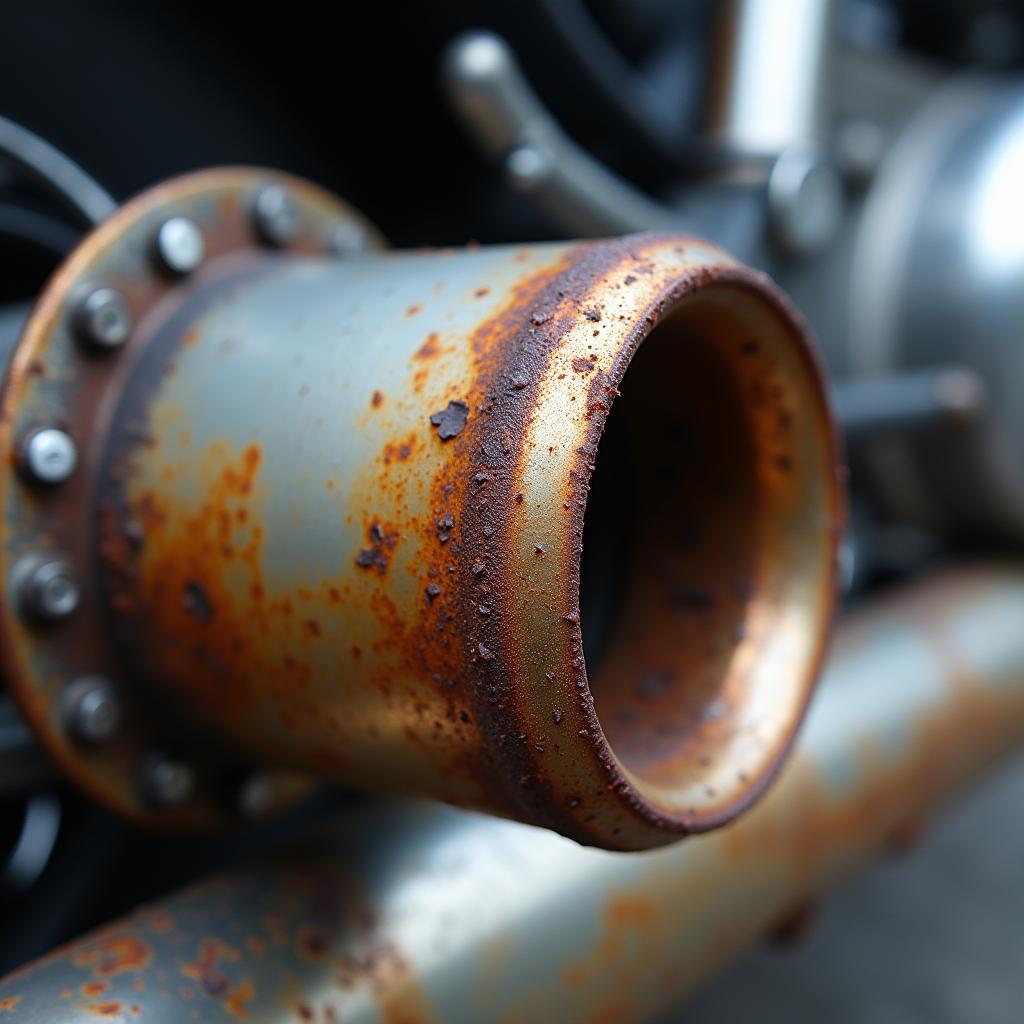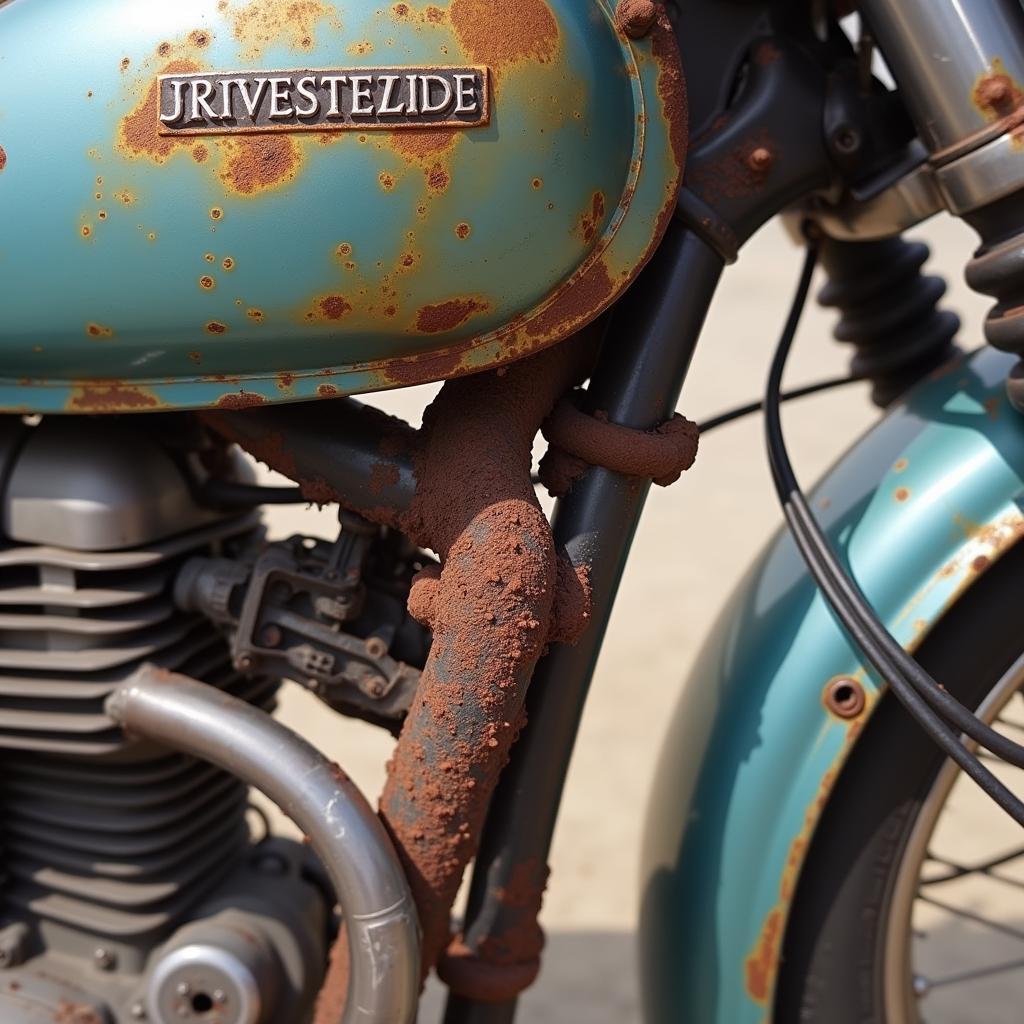A motorcycle isn’t just a means of transportation, but often an expression of personality and passion. But rust can dampen this joy and affect your machine’s value. So, what to do when the first brown spots appear? Don’t worry, in this article you’ll learn how to effectively remove rust from your motorcycle and what you can do to prevent it in the future.
 Close-up view showing rust spots on a motorcycle component
Close-up view showing rust spots on a motorcycle component
Why Is Rust a Problem on Motorcycles?
Rust isn’t just cosmetic damage. Left untreated, it can compromise your motorcycle’s structural integrity and lead to serious damage. Load-bearing parts like the frame, forks, or swingarm are particularly affected. Rust can weaken these parts over time and impair their stability – a safety risk you should definitely avoid.
How Does Rust Form on Motorcycles?
Rust forms through a chemical reaction between iron or steel, oxygen, and water. This so-called oxidation creates a porous layer of iron oxide on the metal surface – rust. Motorcycles are particularly susceptible to rust due to their construction and the use of metals.
Besides weather influences like rain, snow, and high humidity, road salt in winter, bird droppings, or acid rain can also promote rust formation.
 Close-up view showing rust on a motorcycle frame
Close-up view showing rust on a motorcycle frame
Removing Rust from Your Motorcycle: Proven Methods
The good news is: in many cases, rust on motorcycles can be removed relatively easily. Depending on the degree of corrosion, various methods are available to you:
1. Home Remedies for Surface Rust
For light surface rust that hasn’t eaten deep into the metal yet, home remedies can work well. For example:
- Cola: The phosphoric acid it contains helps loosen the rust. Soak affected areas with Cola, let it work, then wipe off with a cloth.
- Lemon and Salt: A mixture of lemon juice and salt also has a rust-dissolving effect. Apply to the rust, let it work, and rub off with a sponge.
- Baking Soda: Mix baking soda with a little water to form a paste and apply to rusty areas. After drying, rub off the paste and polish the surface.
2. Mechanical Rust Removal
For more stubborn rust, you can’t avoid mechanical cleaning. Suitable options include:
- Sandpaper: Use different grits to remove the rust step by step. Start with coarse and work your way up to fine sandpaper.
- Wire Brush: A wire brush, used manually or attached to a drill, effectively removes rust, but should only be used carefully on painted surfaces.
- Sandblasting: Sandblasting is an effective method for heavily rusted parts. This involves blasting fine-grained sand onto the metal under pressure to remove the rust.
3. Chemical Rust Removers
Special rust removers are available commercially, usually based on phosphoric acid or other acids. Apply these products to the rust according to the manufacturer’s instructions, let them work, and then thoroughly remove any residues.
 Person cleaning a motorcycle chain with a brush
Person cleaning a motorcycle chain with a brush
Remember that chemical rust removers can be harmful to the environment. Therefore, use them sparingly and dispose of them properly.
Preventing Rust on Your Motorcycle: How to Protect Your Machine
Prevention is better than cure. With these tips, you can effectively protect your motorcycle from rust:
- Regular Cleaning: Clean your motorcycle regularly with water and a pH-neutral shampoo. This removes dirt, salt, and other deposits that can promote rust formation. Don’t forget to oil the chain to protect it from corrosion. Learn more about Oiling Your Motorcycle Chain in our guide.
- Drying After Washing: After washing, dry your motorcycle thoroughly to avoid standing water. Pay particular attention to hard-to-reach areas.
- Preservation: Treat your motorcycle regularly with a rust inhibitor or anti-corrosion product. This is especially important during the winter months when road salt and humidity promote rust formation.
- Protected Parking Spot: If possible, store your motorcycle in a dry and well-ventilated place. A garage or carport offers optimal protection from weather influences.
- Check for Damage: Regularly check your motorcycle for damage to the paintwork. Small scratches in the paint should be repaired immediately to prevent rust in these areas.
Conclusion: Rust on Your Motorcycle Doesn’t Have to Be
Rust on a motorcycle is annoying but in most cases preventable. With the right care and regular maintenance, you can significantly extend your machine’s lifespan and enjoy its shine for a long time. If you do encounter rust nonetheless, the methods described in this article show you how you can effectively remove it.
Do you have questions about motorcycle care or need help with repairs? Our experts at AutoRepairAid.com are happy to assist you with advice and support. Contact us – we look forward to hearing from you!

